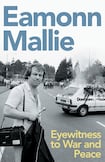
In 2000 I did work experience in the joint newsroom of Downtown Radio and Cool FM, collectively the North’s most listened-to commercial radio stations. Internet and email existed but they were not primary sources of newsgathering or research. Instead the newsroom burbled with the noise of press releases arriving via fax, PRs calling to check whether their press release had been received and occasionally the star reporter phoning in his reports.
I never saw said star, Eamonn Mallie, set foot in the newsroom the week I was there. That was not unusual. The station was located in an obscure industrial estate on the edge of the market town of Newtownards. During the Troubles decades Mallie, the station’s political editor, was the talisman of the northern press corps and was always wherever the action was.
Despite being physically absent from the newsroom, Mallie was ever present. His name – “Mallie!” – uttered in amusement or exasperation. His voice was there, too, either in broadcast reports from the political negotiations still grinding on as the two-year old agreement was haltingly implemented, or on the phone, including once when I answered unwittingly and shrank in awe at the eminence down the line introduced, inevitably, abruptly, as “Mallie!”
Mallie’s distinctive voice (literally and metaphorically) is all over his memoir, Eyewitness to War and Peace. A native of Silverbridge in south Armagh, his accent was never sandpapered by a long period at BBC Broadcasting House (or indeed Montrose). The early part of the book includes an account of his brief and unhappy stint at BBC Northern Ireland, which he found “a little oppressive and parochial” after undergraduate years in Dublin and travel in Europe. Nevertheless, he stayed and made a career in Belfast and the North at a time that was horrific to live through but full of journalistic possibility.
READ MORE
Mallie made the move to Downtown, which “put a big emphasis on frequency of news ... the constant flow of information”. There was certainly plenty to report in Northern Ireland between the 1970s and 2000s, and this book is itself a constant flow of information and anecdote. Mallie’s omnipresence, whether at atrocities, big trials or political talks, means this book can fairly claim to be full of titbits and, appropriately for a news hound, a fair amount of interesting new information. From the claim by a republican source that 80 per cent of IRA members left the organisation after 1998 to additional details on the defenestration of Ian Paisley (more of him later) to the handwritten note from Margaret Thatcher’s press secretary Bernard Ingham advising the Tory prime minister to ignore Mallie’s questions (to Mallie’s evident delight), the book is a hoard of Troubles and peace process-era content.
Getting all this information while reporting for a regional radio station (as well as various freelance roles) required entrepreneurialism or, to put it more directly, pushiness. The photos in the book are a testament to the author’s willingness to get up and close and personal in pursuit of a news line, including one image of a young Mallie quite literally forcing a bewildered Michael Foot on to his back foot at a British Labour Party conference in the early 1980s. And to be fair to Mallie, there were scoops to show for it – including confirmation from Bill Clinton that he would travel to Northern Ireland for a presidential visit and, perhaps most consequentially, his 1993 revelation that the British government was engaged in back-channel contact with the IRA.
It also helped that Mallie cultivated relationships with a diverse cast of powerful players, and not only as sources. His anecdotes about liquid lunches at Abbeville with Charlie Haughey and the Northern painter Basil Blackshaw (fine art being Mallie’s other great pursuit) sit alongside his remarkably close relationship, perhaps even friendship, with Ian Paisley and his family. The latter relationship led to extensive access and a post-retirement documentary that did much to detoxify Paisley’s reputation.
Such recollections create the inevitable sense of a passing era. The long period of conflict, followed by a long post-conflict political process, played out by big, mostly male, characters, is largely over.
Unmistakably brand Mallie as this book is, it is also the latest in a series of journalists’ memoirs of the era, including those of Barney Rowan, formerly of the BBC, Deric Henderson of the Press Association and Tommie Gorman, who spent a large chunk of his career in Belfast. None were quite as singular as Mallie, but what all the books share is a general sense of relief at having come through an appalling conflict and having been able to report on its end. As poignant and cathartic as that ending was, we are still struggling to move on from the fact of peace to figuring out what we want to do with it.
Matthew O’Toole is an SDLP MLA and leader of the opposition at Stormont













